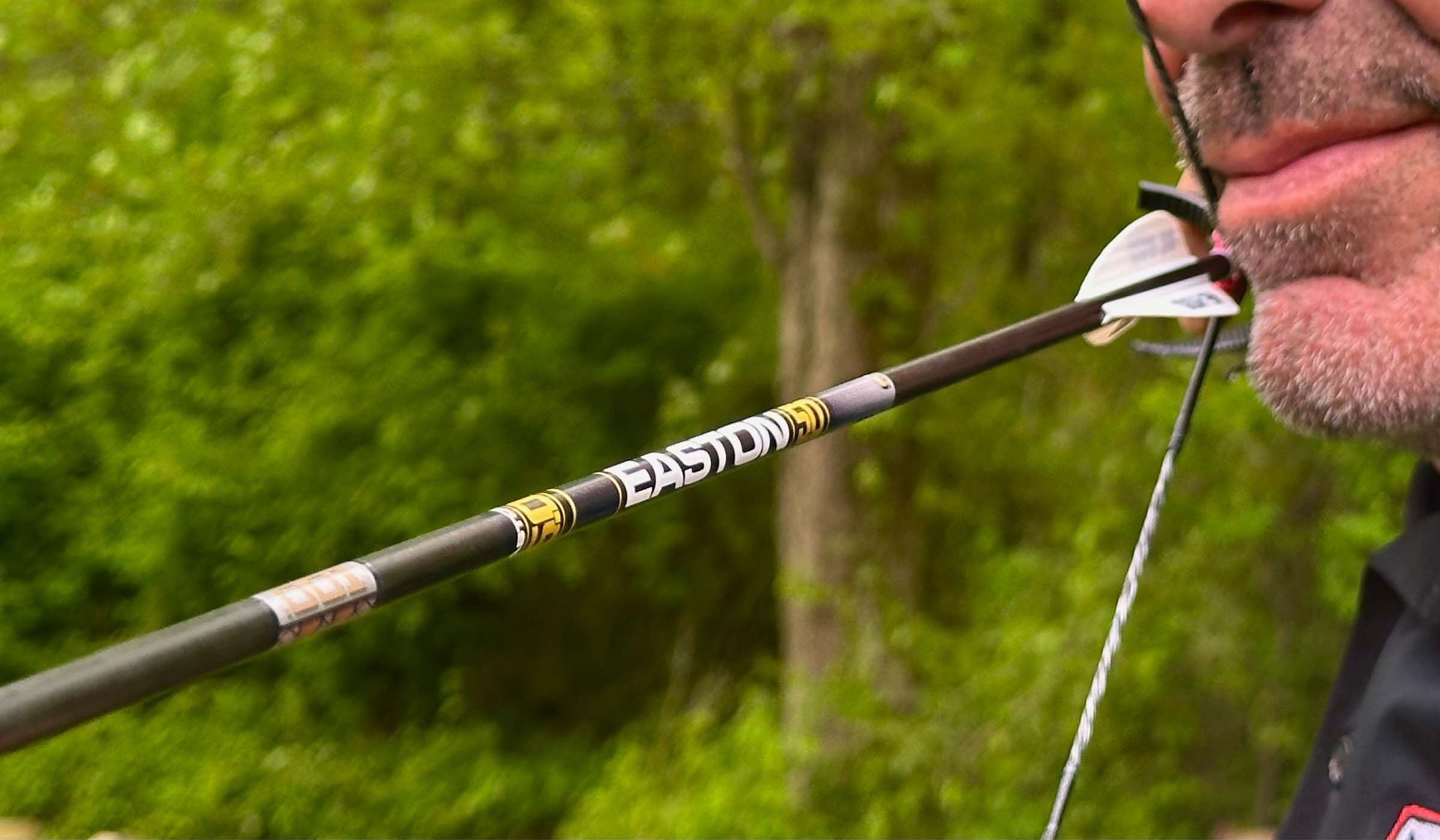We may earn revenue from the products available on this page and participate in affiliate programs. Learn More ›
It’s an exciting time to be a bowhunter. In just about every product category associated with bowhunting, there are more options at more price points than ever before. It wasn’t terribly long ago when that wasn’t the case.
For example, if you come across a photo of bowhunters from the mid to late 1990s, odds are pretty high the arrows in their quivers are Easton XX75 Gamegetters. There were other arrows on the market, but the XX75 Gamegetters were widely considered to be the only real choice.
Today, there are many quality hunting arrows on the market, offered by multiple companies. Easton is still in the game, but the field is much deeper now. You’re just as likely to see bowhunters shooting Gold Tip, Victory, or Black Eagle arrows today as you are Eastons.
Brands aside, you’ve also got choices today between micro and standard diameters, heavy arrows or light, carbon or aluminum – or both – pre-fletched or bare shafts, and on and on. Instead of choosing one arrow to serve all your bowhunting needs, you can build certain arrows for specific applications, like having a micro-diameter, lightweight arrow for hunting pronghorns on the prairie and a heavyweight, high-FOC arrow for chasing moose in the timber.
In my job working for Lancaster Archery Supply, one of the leading suppliers of bowhunting and target archery gear to pro shops and individuals around the world, I get the chance to see and shoot pretty much every new arrow as it’s introduced to the market. Likewise, I get to see which arrows are returned to us by customers due to performance issues. Based on that experience, here are our picks for the best hunting arrows.
The Best Hunting Arrows: Reviews and Recommendations
Best Overall: Easton 5.0
Photo by P.J. Reilly
Buy From Lancaster Archery Supply
Pros
- Ultralight
- Micro-diameter
- Unmatched consistency
- Has compatible components that allow for building lightweight, fast arrows, or high-FOC bone crunchers
Cons
- Not the very best option for shooting long distances
Key Features
-
.001 and .003 straightness versions -
Spines:
200, 250, 300, 340, 400, and 500 -
Compenents:
Halfouts or HIT inserts -
Made in USA -
Inside Diameter:
.204 inch -
Weight (340 spine):
7.4 grains per inch -
Price (.003):
$110 (6 fletched arrows), $170 (dozen shafts)
Easton finally built the ultimate arrow when they came out with the 5.0 late last year. Due to incredible demand, bowhunters are just starting to get them in their hands now.
The 5.0 is more than just an arrow – it’s an arrow system because you can build it the way you want. To start, it’s a 5mm arrow built using Easton’s Acu-Carbon process, which was made famous by the Axis series of arrows. Instead of rolling the carbon around a mandril to form the shaft, Easton weaves the carbon over the mandril in a continuous process.
This construction minimizes the effect of a “high spine,” which is a line of stiffer carbon running the length of the arrow commonly found when the carbon is rolled. Ideally, you want to identify that high spine and make sure it’s facing up when you load the arrow to shoot. Because of the 5.0’s construction, that orientation is less critical than it is with other shafts. Also, the continuous weave means the first arrow off the line will match the 387,000th arrow off the line, and every one in between. Buy a dozen this year, and the weights and straightness tolerances will match the dozen you buy three years from now.
Where Easton hit the 5.0 out of the park is in making the shaft super light. The 300-spine 5.0 weighs 8.4 grains per inch. That’s not the lightest arrow on the market, but it’s pretty light. So if you’re looking for a flat-shooting arrow, you can build the 5.0 to be super light. Put in the aluminum HIT inserts and some 2.5-inch fletchings, and you’ve got a real speed burner.
Easton has a series of components made for the 5.0 that allow you to add weight to the front to make the arrow hit like a sledgehammer while maintaining long-range accuracy. You can build a 5.0 arrow with 15 percent FOC that’s still a viable, long-range arrow, as opposed to one that weighs 700 grains.
Easton has a series of components that allow you to build the 5.0 arrow you want. There are inserts that weigh 16 grains, 25 grains, 50 grains, and 75 grains. You decide how much weight you want in the front of your arrow to get the performance you’re looking for.
Along with that, Easton offers the 5.0 in 200, 250, 300, 340, 400 and 500 spines. The varied spine offerings are critical for building high-FOC arrows that will still fly well. One of the common mistakes bowhunters make in building arrows with high FOC, is they don’t consider the effect that added weight has on the arrow spine.
The more weight you add to the front of an arrow, the weaker the spine gets. So a hunter shooting a 70-pound draw weight with a 29-inch arrow would want that arrow to be 300 spine with a 100-grain point. If the hunter adds 50-100 grains to the front of that arrow, the correct spine for solid arrow performance is going to change to 250 or even 200. But bowhunters don’t realize that, so they end up sticking with the now-weakened 300, which likely won’t always fly well – especially as the shooting distance increases.
Read Next: Best Bow Sights
Best Long Range: Victory HLR Elite
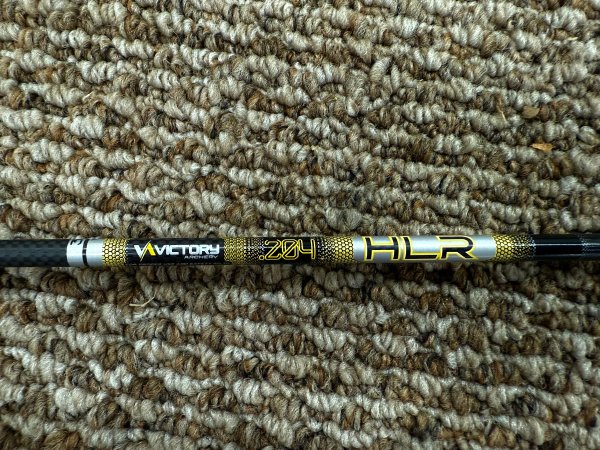
Photo by P.J. Reilly
Buy From Cabela’s
Buy From Lancaster Archery Supply
Pros
- Super durable 1.5K carbon
- Nano ceramic coating makes the arrows easy to pull from targets
Key Features
-
.204 Micro-diameter -
Every arrow is spine aligned -
.001, .003 and .006 versions available -
Prices (shafts):
$190 to $235
The Victory HLR – Hunt Long Range – was built with the long-range bowhunter in mind, whether that person is actually hunting or shooting targets at long range. The carbon that’s used to make the arrows has a unique weave pattern that’s designed to help the arrow recover faster in flight.
When an arrow leaves a bow, it flexes. The faster it can stop flexing and fly straight, the less drag it produces and the flatter its trajectory will be. The flatter the trajectory, the greater distances an archer can shoot the arrows.
The 1.5K carbon is a carbon weave made of 1,500 carbon filaments per bundle. It’s the bundles that are woven together to create the carbon fabric that’s rolled into an arrow shaft. This type of carbon is valued for its high strength-to-weight ratio. It’s very strong but still super light. The 300-spine HLR Elite arrow shaft weighs just 8.1 grains per inch. That’s among the lightest arrows on the market at that spine.
The .204 diameter of the HLR is considered a micro-diameter, which is ideal for cutting through the wind. The skinnier the arrow, the less surface area there is for the wind to push against.
Something Victory does with the HLR that not all arrow manufacturers do is the company marks on each arrow shaft the location of the stiffest axis. That is, the seam running the length of the arrow that is the stiffest. By knowing this, archers shooting compound bows can fletch their arrows so that this stiffest part is always facing up. Arrows leaving compound bows flex up and down, rather than side-to-side, as they do from recurve bows, and so the most consistent arrow flight is produced when the stiff axis of every arrow faces up when shot from the bow.
Compound target archers often figure out where the high spine of an arrow is on their own – assuming it’s not marked by the manufacturer – to help achieve same-hole consistency from arrow to arrow. Little details like this are more critical when shooting at longer distances than when shooting 40 yards and under.
Read Next: Best Fletching Jigs
Best Lightweight: Victory RIP XV Xtreme Velocity Elite
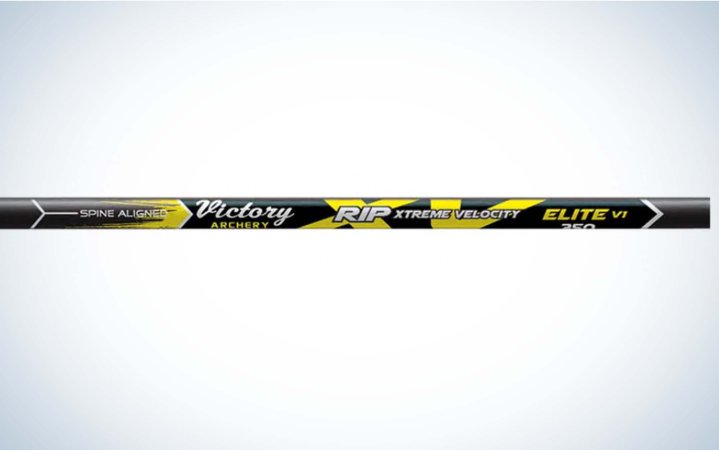
By From Lancaster Archery Supply
Pros
- Lightest grains-per-inch weight in most spines
- High-modulus carbon is durable
- Nano ceramic coating makes for easy removal from targets
Cons
- Extra components required for high foc set ups
Key Features
-
Weight (350 spine):
6.4 grains per inch -
.204 micro-diameter -
Spine aligned -
.001 straightness -
Spines:
200, 250, 300, 350, 400, and 500 -
Price (shafts):
$180
The Victory RIP XV Xtreme Velocity Elite is built for one purpose – speed. At the most popular spines, it’s the lightest arrow among the major manufacturers. The 7.1 grains-per-inch weight of the RIP XV’s 300 spine is unmatched in the arrow world. The .204 diameter isn’t the smallest in the arrow world, but it’s still considered micro-diameter and will minimize wind drift.
One of the downfalls of ultralight arrows is they can break easily. That’s not a problem with the RIP XV Extreme Velocity. Victory is part of Mitsubishi Chemical America, which is one of the world leaders in carbon technology. The carbon fiber used to make the RIP XV Xtreme Velocity is strong and durable. These arrows can take a beating.
I chose the Elite version of this arrow for the best lightweight arrow, which is Victory’s highest-rated version, with a straightness tolerance of .001 inches. There are also versions with .003-inch and .006-inch straightness tolerances. Truth be told, most archers probably won’t notice a difference between the versions, but if you want the best, get the Elites. The Elites also are sorted so that every arrow will weigh within a half-grain of one another. Again – tight tolerances mean tight groups.
Every RIP XV Xtreme Velocity arrow is spine aligned, which means Victory identifies the high spine for you so that you can fletch your arrows with that line facing up for consistent performance. Also, Victory’s Nano Ceramic ICE coating is among the best in the game. Shoot these arrows and some others that don’t have the coating into a foam 3D target in cold weather and you’ll appreciate the coating. It just makes arrow removal much nicer.
Read Next: Best Bow Quivers
Best Value: Black Eagle Talon V2 Fletched (.003)
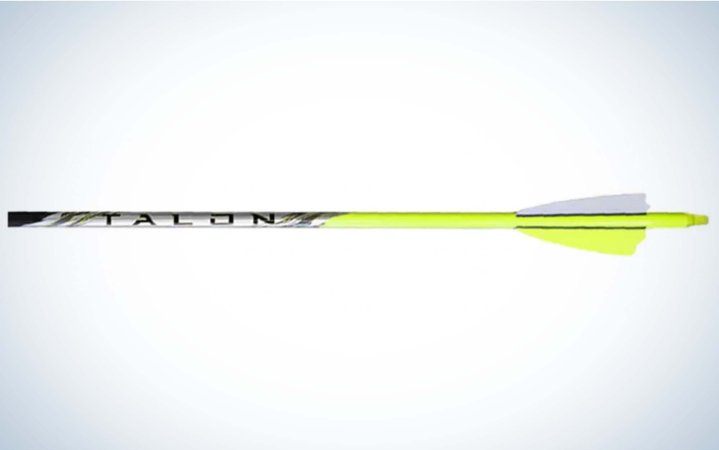
Buy From Lancaster Archery Supply
Pros
- Great value
- Bright and easy to see
Key Features
-
Factory crested and fletched -
.244 diameter -
High-modulus carbon -
Six pack of arrows at $70
The Black Eagle Talon V2 Fletched .003 arrows represent the ultimate in convenience, simplicity, and affordability. This is a six pack of factory crested and pre-fletched arrows, so all the customer has to do upon buying a pack is to have the arrows cut to length and then glue in the included inserts. No arrow wraps are needed. No fletching required. And the pack sells for just $70. That’s a bargain.
Often times with these factory-fletched six packs, there is no cresting – a bright paint or sticker that serves the same purpose as a wrap – and the fletchings are kind of cheap. The Talon V2 Fletched .003 arrows include neon-yellow cresting and 2.5-inch Q2i shield cut fletchings. These are high-quality, durable fletchings that will work well for shooting field points or fixed-blade broadheads.
At the factory, Black Eagle “super sorts” these arrows to make sure that each arrow within a given pack weighs within 1 grain of all the others and that the spines and straightness tolerances are also equally precise. That’s the pinnacle of consistency, and it’s rare among lower-priced arrows.
We picked the Talons with .003 straightness, which isn’t the tightest tolerance, but it’s pretty good. Most bowhunters aren’t likely to notice an issue where straightness variances affect performance. And the .003 six pack of this arrow is $20 cheaper than the .001 version.
Made of high-modulus carbon, the .244-diameter Talons are available in 300, 350, 400 and 500 spines. That will cover a broad spectrum of draw lengths and weights.
Best Heavyweight: Easton FMJ Max 5mm Match Grade
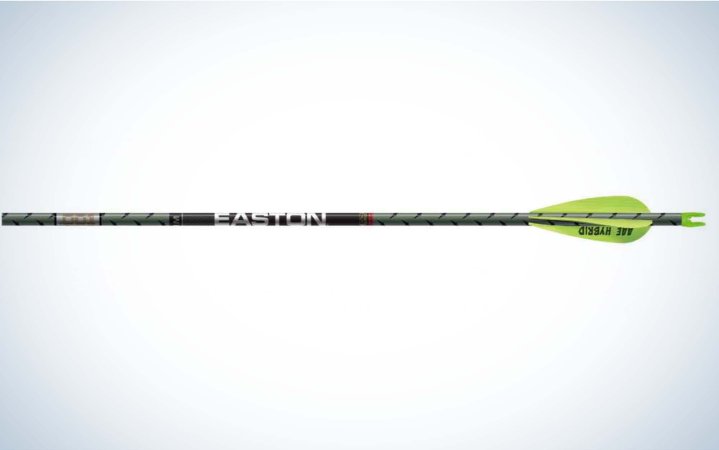
Buy From Lancaster Archery Supply
-
Carbon core wrapped in aluminum -
5mm diameter -
Stiffest spine is 200 -
One of the heaviest arrows on the market
The Easton FMJ has been the gold standard for heavyweight arrows for many years. No one else makes arrows as heavy as the FMJ.
New for 2025, Easton has introduced the FMJ Max 5mm Match Grade. Think of it as the FMJ 2.0. It’s actually not quite as heavy as the standard 5mm FMJ. For example, the 300 spine FMJ Max 5mm Match Grade weighs 10.3 grains per inch, as compared to the FMJ 5mm, which weighs 12 GPI.
So why would we pick a lighter arrow as our best heavyweight? For starters, the carbon core of the FMJ Max is made using Easton’s Acu-Carbon process, where the standard FMJ is not. The Acu-Carbon process is a continuous weave of carbon around a mandril. It ensures consistency of spine, weight, and straightness from shaft No. 1 to shaft No. 1 million.
Also, the slightly lighter overall weight of the arrow makes it easier to beef up the FOC. You’re already shooting a heavy arrow, so you might want to have a high FOC for ultimate performance and penetration. Well that’s easier to do with a slightly lighter arrow. It would take greater point weight to increase the FOC of an overall heavier arrow shaft.
This is where the 200-spine offering is important. A bowhunter pulling 70 pounds and shooting an arrow around 30 inches long is likely going to need to go to the 200 spine to beef up the arrow’s FOC. The amount of point weight needed to boost the FOC of a 300-spine, FMJ Max 5mm arrow is likely going to substantially weaken that arrow. The hunter would be better served moving up to the 200-spine arrow with super-heavy point weight in order to maintain good arrow performance in flight.
The FMJ Max 5mm is now a Match Grade arrow, which means Easton takes the greatest precautions to ensure straightness, weight and spin, so that every arrow matches every other arrow as close as possible. That’s critical for consistent performance.
Most Unique: Ultraview UV 1K

P.J. Reilly
Buy from Lancaster Archery Supply
Pros
- Designed point to nock for peak performance
Cons
- Only sold as a complete arrow system
Key Features
-
4.5mm diameter -
Made of 1K carbon weave -
Pre-fletched with proprietary vanes -
Weight (300 spine):
8.7 grains per inch -
Price:
$220 (six pack)
There are many 4mm, 5mm, and 6mm arrows in the market. There is only one 4.5mm. There are many pre-fletched arrows on the market. There’s only one where the vanes included were designed to maximize the aerodynamics of the specific arrow that carries them. There are many arrows sold with inserts included in the pack. There’s only one that comes with inserts and field points.
The UV 1K is one of one in the arrow world. There’s nothing else like it. And that was the intent of Ultraview in creating the UV 1K. If you want to stand out in a crowded field, you have to be different.
The UV 1K arrow is built from 1K carbon. That’s a special grade of carbon that emphasizes high strength in a lightweight package. The carbon used to make arrows is a woven mesh of carbon fibers. The UV 1K utilizes carbon that’s based on 1,000 fibers per tow – or bundle. Most carbon used for arrows is built on 3K carbon – 3,000 fibers per tow – which tends to be heavier.
If 1K carbon is so much better, then why isn’t everyone using it? Well, it’s harder to get, which means it’s more expensive. In light of that, the UV 1K is expensive. There’s only one hunting arrow sold by Lancaster Archery Supply that costs more.
Aside from the unique carbon, the UV 1K is a 4.5mm diameter arrow. It’s a compromise between the wind-cutting properties of the 4mm arrows and the durability and light weight of the 5mm arrows.
UV 1K arrows are sold only as complete, fletched sets. The fletchings are made from injection molds, with unique thick and thin areas designed specifically to make this arrow fly like a dart. The arrows include uniquely-shaped wraps under the fletchings and hardened field points with O-rings so they don’t come loose.
Read Next: UltraView 1K Arrows Review
Things to Consider Before Buying a Hunting Arrow
There’s a strong case for an arrow being more important for accuracy than your bow. I’ll let that debate rage on Facebook, while I give you some food for thought when choosing the best hunting arrow for you.
How far are you shooting?
We’d all like to think we are as good as Levi Morgan, but you’re not and I’m not. So, be realistic when considering how far you’ll be shooting at critters. If it’s a close range, like 30 yards, you have a lot of options. If it’s a further range than you might want to consider a micro-diameter arrow for reduced wind drift.
What are you hunting?
If you’re a single-species hunter, building an arrow that’s specific to that animal is beneficial. For example, if you just hunt elk, a hard-hitting, micro diameter arrow is a great choice. If you’re hunting antelope and elk, a middle of the road arrow is the way to go.
Find a Happy Medium
In a world of extremes, sometimes it’s best to find the middle of the road. Some people will tell you a light 350-grain arrow is the special sauce for killing everything in North America. While others will tell you a 700-grain arrow is what you need to get a pass through on whitetails. For most people, a middle ground between those two setups will be perfect, something in the 450 to 500-grain total arrow weight range.
FAQs
The best hunting arrow is tailored to the animal you’re hunting, the type of hunting you do, and has a spine that matches your bow. If you’re treestand hunting whitetails where your farthest shot is 30 yards, you’ll want a different arrow than if you’re spot-and-stalk hunting mule deer above treeline.
There are three main specs for an arrow: weight consistency, spine tolerance, and straightness tolerance. Of these, spine tolerance is the most important, followed by straightness, and then weight tolerance. So, the most accurate arrows have tight tolerances and are tuned to the bow firing them.
A durable carbon arrow has a thick wall, which is the thickness of the carbon. They are also made from quality carbon fiber. Today’s market is filled with tough carbon arrows. When looking for a tough arrow look for a heavy micro-diameter arrow with stainless steel components that reinforce the front of the shaft.
Final Thoughts on the Best Hunting Arrows
There are tons of options to choose from when you pick your arrow for bowhunting this season. Odds are, there’s an arrow out there that will do what you need it to do: whether that’s fly super fast, punch through a big bull elk, keep your bank account from imploding, or all of the above. The days of having just one or two arrows to choose from are long gone. Do your homework and choose wisely.
Read the full article here



